Revisiting a Mei-Yu Front Associated with Heavy Rainfall over Taiwan during 6–7 June 2003
Abstract
1. Introduction
2. Data and Methods
3. Evolution of Weather Patterns
4. The Secondary Circulation across the Mei-Yu Jet/Front System
5. Coupling between the Secondary Circulation and Dynamic Forcing Aloft
6. Moisture Transport and Heavy Rainfall over Taiwan
7. Summary
Author Contributions
Funding
Institutional Review Board Statement
Informed Consent Statement
Data Availability Statement
Acknowledgments
Conflicts of Interest
References
- Kuo, Y.H.; Chen, G.T.J. The Taiwan area mesoscale experiment (TAMEX): An overview. Bull. Amer. Meteor. Soc. 1990, 71, 488–503. [Google Scholar] [CrossRef]
- Chen, Y.L.; Zhang, Y.X.; Hui, N.B. Analysis of a surface front during the early summer rainy season over Taiwan. Mon. Wea. Rev. 1989, 117, 909–931. [Google Scholar] [CrossRef]
- Chen, G.T.J.; Chang, C.P. The structure and vorticity budget of an early summer monsoon trough (Mei-Yu) over southeastern China and Japan. Mon. Wea. Rev. 1980, 108, 942–953. [Google Scholar] [CrossRef]
- Hsiao, F.; Chen, Y.L. Revisiting the structure and characteristics of an early summer monsoon trough over South China in 1975. SOLA. 2014, 10, 194–198. [Google Scholar] [CrossRef]
- Uppala, S.M.; KÅllberg, P.W.; Simmons, A.J.; Andrae, U.; Bechtold, V.d.; Fiorino, M.; Gibson, J.K.; Haseler, J.; Hernandez, A.; Kelly, G.A.; et al. The ERA-40 re-analysis. Quart. J. Roy. Meteor. Soc. 2005, 131, 2961–3012. [Google Scholar] [CrossRef]
- Chen, Y.L.; Hui, N.B. Analysis of a relatively dry front during the Taiwan Area Mesoscale Experiment. Mon. Wea. Rev. 1992, 120, 2442–2468. [Google Scholar] [CrossRef]
- Chen, Y.L.; Hui, N.B. Analysis of a shallow front during the Taiwan Area Mesoscale Experiment. Mon. Wea. Rev. 1990, 118, 2649–2667. [Google Scholar] [CrossRef][Green Version]
- Trier, S.B.; Parsons, D.B.; Matejka, T.J. Observations of a subtropical cold front in a region of complex terrain. Mon. Wea. Rev. 1990, 118, 2449–2470. [Google Scholar] [CrossRef]
- Chen, Y.L. Some synoptic-scale aspects of the surface fronts over southern China during TAMEX. Mon. Wea. Rev. 1993, 121, 50–64. [Google Scholar] [CrossRef]
- Chen, C.Y.; Chen, Y.L.; Chen, C.S.; Lin, P.L.; Liu, C.L. Revisiting the heavy rainfall event over northern Taiwan on 3 June 1984. Terr. Atmos. Ocean. Sci. 2013, 24, 999–1020. [Google Scholar] [CrossRef]
- Tu, C.C.; Chen, Y.L.; Chen, C.S.; Lin, P.L.; Lin, P.H. A comparison of two heavy rainfall events during the Terrain-influenced Monsoon Rainfall Experiment (TiMREX) 2008. Mon. Wea. Rev. 2014, 142, 2436–24631. [Google Scholar] [CrossRef]
- Tu, C.C.; Chen, Y.L.; Lin, P.L.; Huang, M.Q. Analysis and simulations of a heavy rainfall event associated with the passage of a shallow front over Northern Taiwan on 2 June 2017. Mon. Wea. Rev. 2022, 150, 505–528. [Google Scholar] [CrossRef]
- Chen, L.; L, Y.; Chu, Y.J.; Chen, C.S.; Tu, C.C.; Teng, J.H.; Lin, P.L. Analysis and simulations of a heavy rainfall event over northern Taiwan during 11–12 June 2012. Mon. Wea. Rev. 2018, 146, 2697–2715. [Google Scholar] [CrossRef]
- Chen, G.T.J.; Wang, C.C.; Chang, S.W. A diagnostic case study of Mei-yu frontogenesis and development of wavelike frontal disturbances in the subtropical environment. Mon. Wea. Rev. 2008, 136, 41–61. [Google Scholar] [CrossRef]
- Chen, Y.L.; Tu, C.C.; Hsiao, F.; Chen, C.S.; Lin, P.L.; Lin, P.H. An overview of Low-Level Jets (LLJs) and their roles on heavy rainfall over the Taiwan area during the early summer rainy season. Meteorology 2022, 1, 64–112. [Google Scholar] [CrossRef]
- Chen, G.T.J.; Yu, C. Study of low-level jet and extremely heavy rainfall over northern Taiwan in the Mei-Yu Season. Mon. Wea. Rev. 1988, 116, 884–8912. [Google Scholar] [CrossRef]
- Chen, G.T.J.; Wang, C.C.; Lin, D.T.W. Characteristics of low-level jets over northern Taiwan in the Mei-Yu season and their relationship to heavy rain events. Mon. Wea. Rev. 2005, 133, 20–43. [Google Scholar] [CrossRef]
- Chen, C.S.; Lin, Y.L.; Peng, W.C.; Liu, C.L. Investigation of a heavy rainfall event over southwestern Taiwan associated with a subsynoptic cyclone during the 2003 Mei-Yu season. Atmos. Res. 2010, 95, 235–254. [Google Scholar] [CrossRef]
- Tu, C.C.; Chen, Y.L.; Lin, P.L.; Du, Y. Characteristics of the marine boundary layer jet over the South China Sea during the early summer rainy season of Taiwan. Mon. Wea. Rev. 2019, 147, 457–475. [Google Scholar] [CrossRef]
- Tu, C.C.; Chen, Y.L.; Lin, P.L.; Lin, P.H. The relationship between the boundary layer moisture transport from the South China Sea and heavy rainfall over Taiwan. Terr. Atmos. Ocean. Sci. 2020, 31, 159–176. [Google Scholar] [CrossRef]
- Saha, S.; Moorthi, S.; Pan, H.L.; Wu, X.R.; Wang, J.D.; Nadiga, S.; Tripp, P.; Kistler, R.; Woollen, J.; Behringer, D.; et al. The NCEP climate forecast system reanalysis. Bull. Amer. Meteor. Soc. 2010, 91, 1015–10581. [Google Scholar] [CrossRef]
- Kerns, B.; Chen, Y.L.; Chang, M.Y. The diurnal cycle of winds, rain and clouds over Taiwan during the Mei-Yu, summer, and autumn regimes. Mon. Wea. Rev. 2010, 138, 497–516. [Google Scholar] [CrossRef]
- Zhu, Y.; Newell, R.E. A proposed algorithm for moisture fluxes from atmospheric rivers. Mon. Wea. Rev. 1998, 126, 725–735. [Google Scholar] [CrossRef]
- Lavers, D.A.; Villarini, G.; Allan, R.P.; Wood, E.F.; Wade, A.J. The detection of atmospheric rivers in atmospheric reanalyses and their links to British winter floods and the large-scale climatic circulation. J. Geophys. Res. 2012, 117, D20106. [Google Scholar] [CrossRef]
- Rossby, C.G. Planetary flow patterns in the atmosphere. Quart. J. Roy. Meteor. Soc. 1940, 66, 68–87. [Google Scholar]
- Ertel, H. Ein neuer hydrodynamischer Wirbelsatz. Meteor. Z. 1942, 59, 277–281. [Google Scholar]
- Chen, Y.L.; Chen, X.A.; Zhang, Y.X. A diagnostic study of the low-level jet during TAMEX IOP 5. Mon. Wea. Rev. 1994, 122, 2257–2284. [Google Scholar] [CrossRef]
- Chen, Y.L.; Chen, X.A.; Chen, S.; Kuo, Y.H. A numerical study of the low-level jet during TAMEX IOP 5. Mon. Wea. Rev. 1997, 125, 2583–2604. [Google Scholar] [CrossRef]
- Chen, X.A.; Chen, Y.L. Development of low-level jets during TAMEX. Mon. Wea. Rev. 1995, 123, 1695–1719. [Google Scholar] [CrossRef]
- Chen, Y.L.; Tseng, S.F. Comments on “The intensification of the low-level jet during the development of mesoscale convective systems on a Mei-Yu front”. Mon. Wea. Rev. 2000, 128, 1123–1138. [Google Scholar] [CrossRef]
- Chen, X.A.; Chen, Y.L. Kinetic energy budgets of the low-level jet during TAMEX IOP 5. J. Meteor. Soc. Japan. 2002, 80, 1–19. [Google Scholar] [CrossRef]
- Shin, C.-S.; Lee, T.-Y. Development mechanisms for the heavy rainfalls of 6–7 August 2002 over the middle of the Korean Peninsula. J. Meteor. Soc. Japan 2005, 83, 683–709. [Google Scholar] [CrossRef][Green Version]
- Park, C.; Son, S.; Kim, J.-H. Role of baroclinic trough in triggering vertical motion during summertime heavy rainfall events in Korea. J. Atmos. Sci. 2021, 78, 1687–1702. [Google Scholar] [CrossRef]
- Chen, -L.Y.; Li, J. Large-scale conditions favorable for the development of heavy precipitation during TAMEX IOP 3. Mon. Wea. Rev. 1995, 123, 2978–3002. [Google Scholar] [CrossRef][Green Version]
- Du, Y.; Chen, G.X. Climatology of low-level jets and their impact on rainfall over southern China during the early-summer rainy season. J. Climate 2019, 32, 8813–8833. [Google Scholar] [CrossRef]
- Du, Y.; Chen, G.X.; Han, B.; Mai, C.; Bai, L.; Li, M. Convection initiation and grow that the coast of South China. Part I: Effect of the marine boundary layer jet. Mon. Wea. Rev. 2020, 148, 3847–3869. [Google Scholar] [CrossRef]
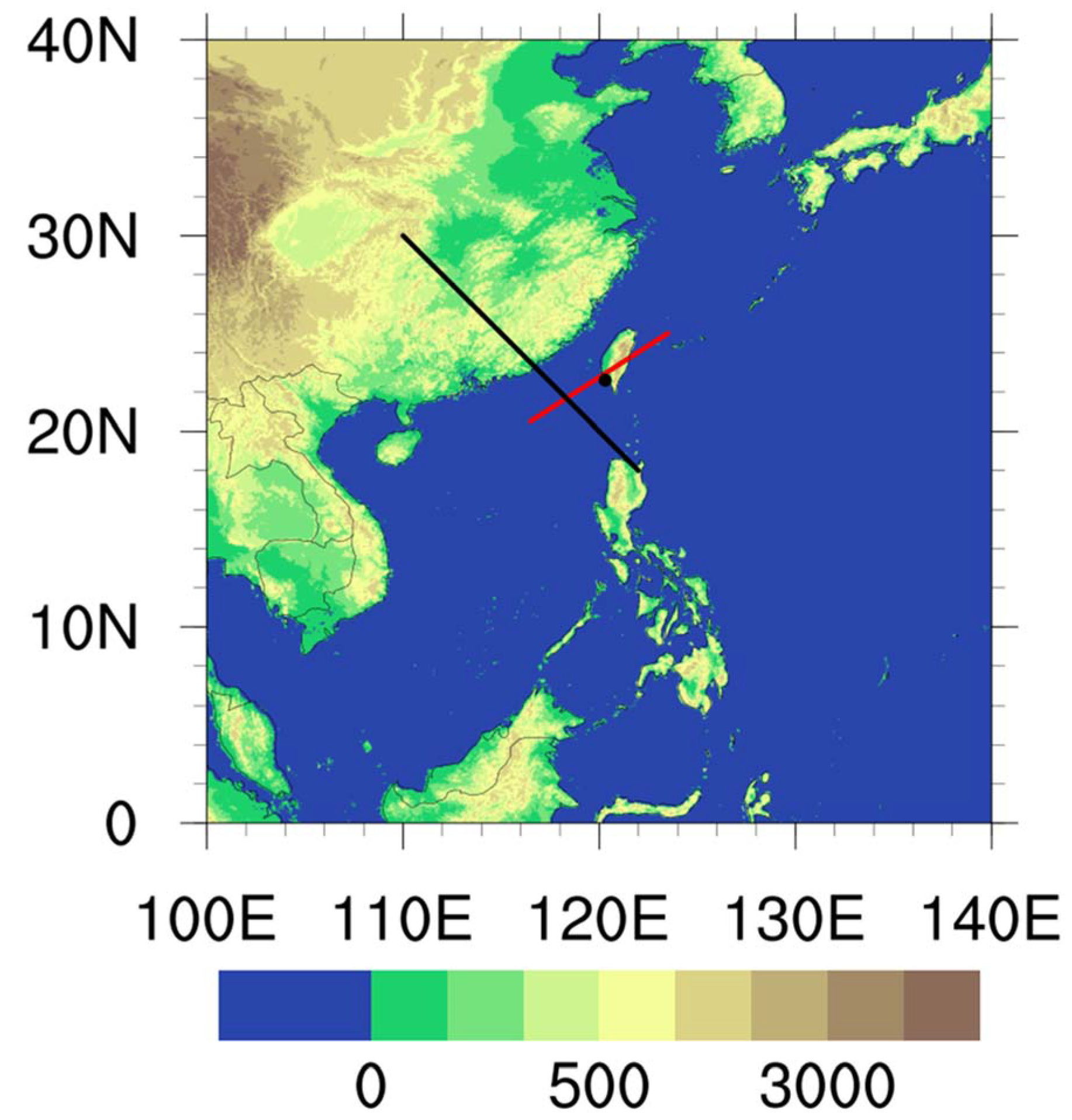
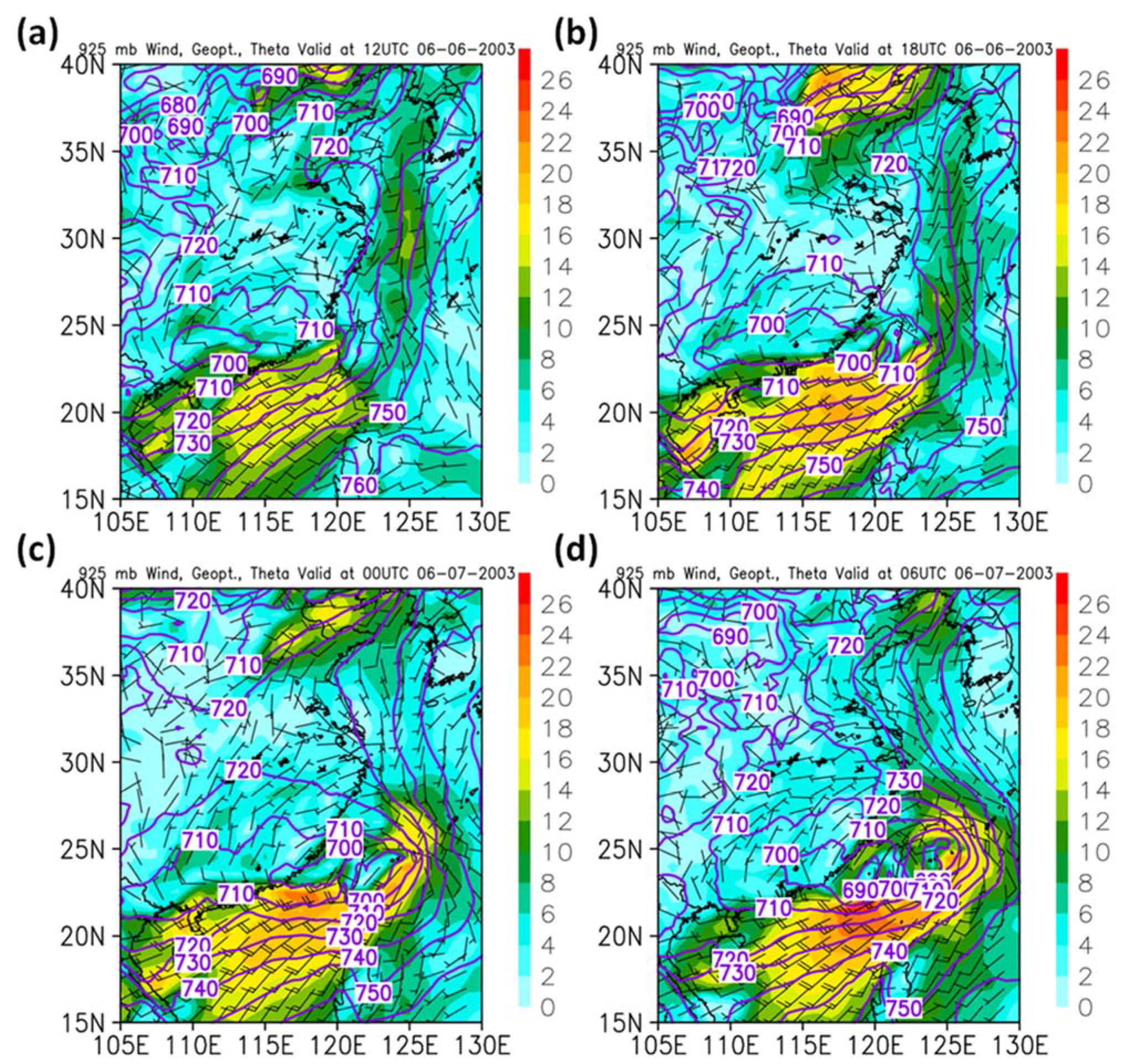
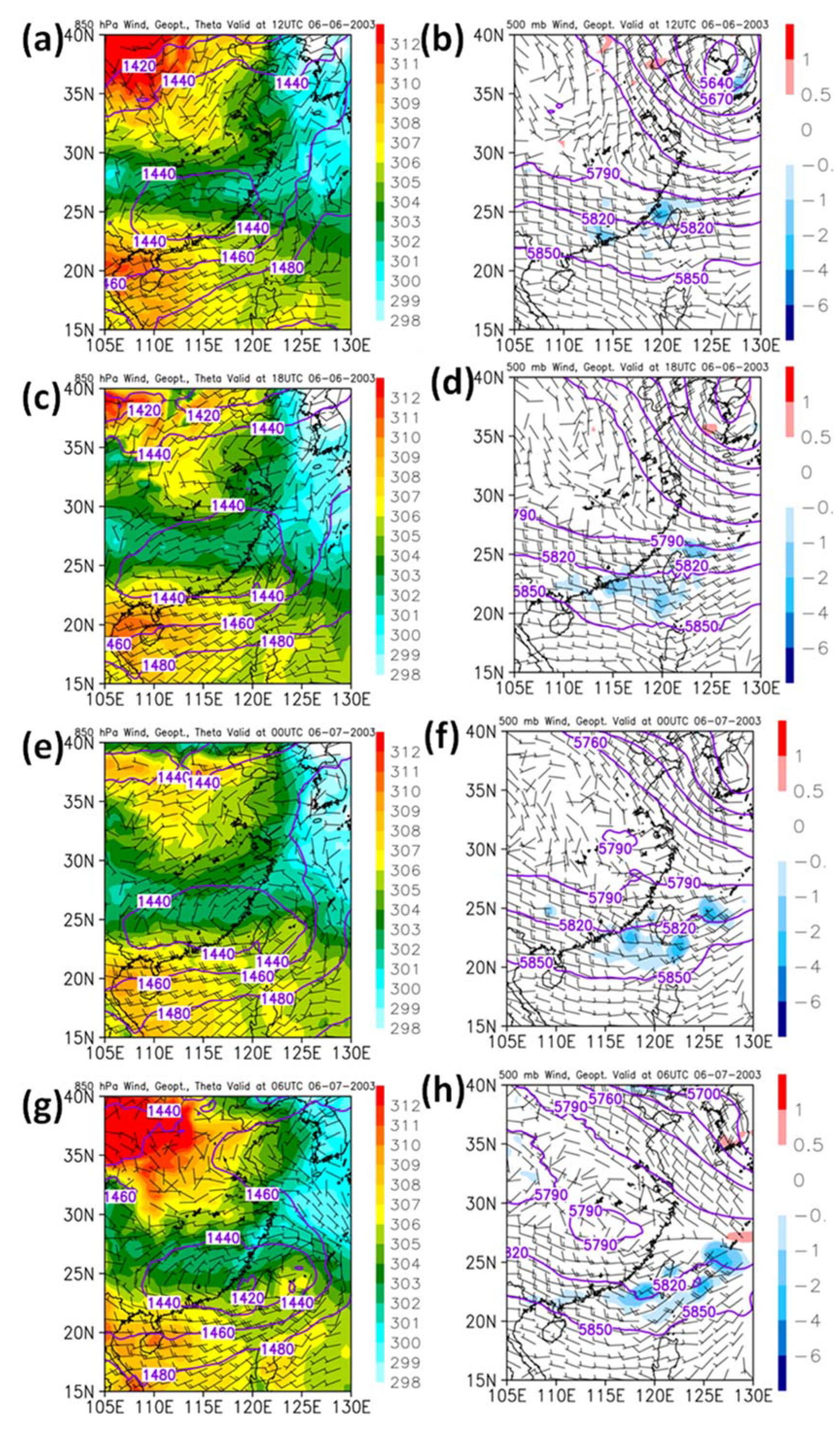
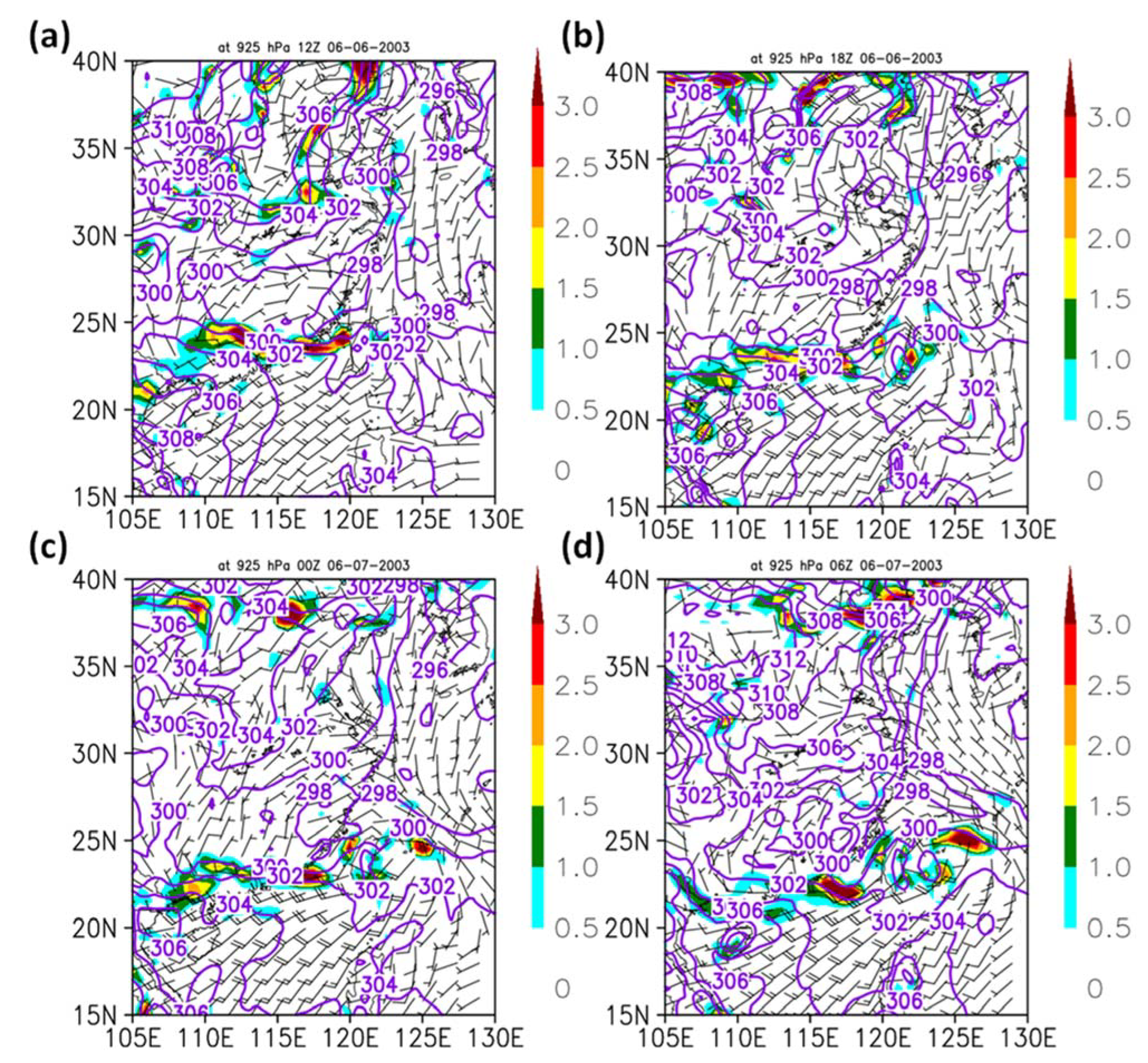
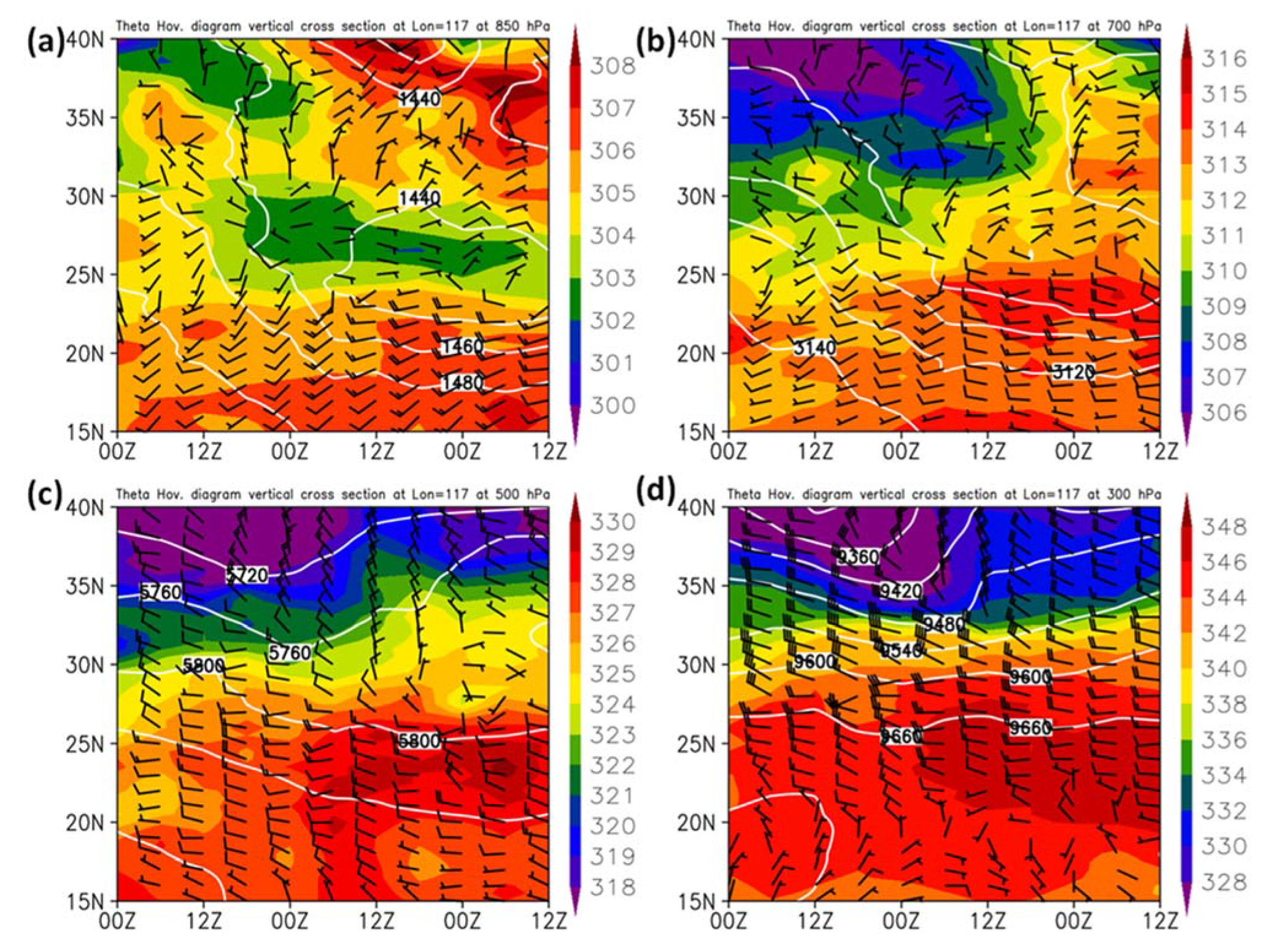
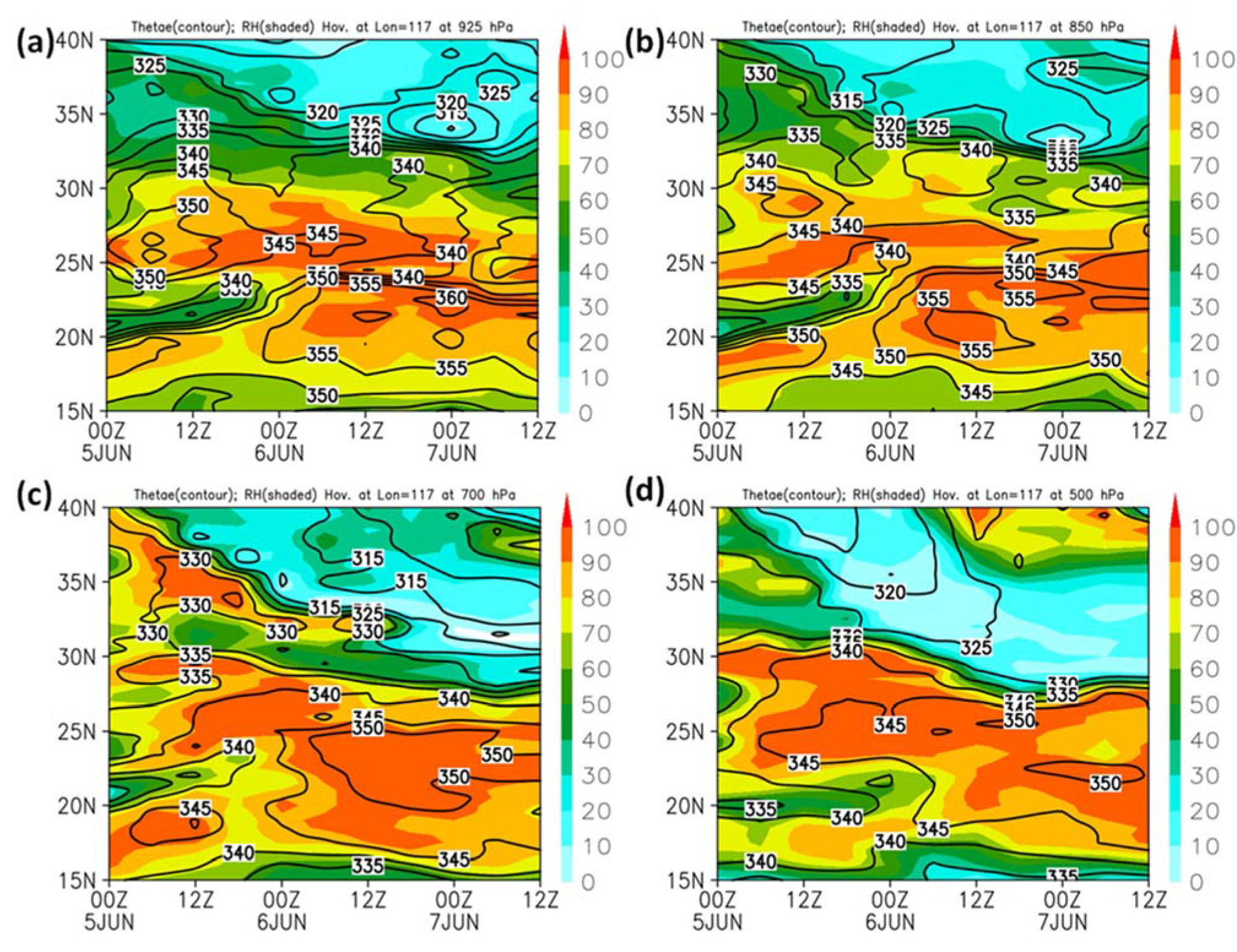
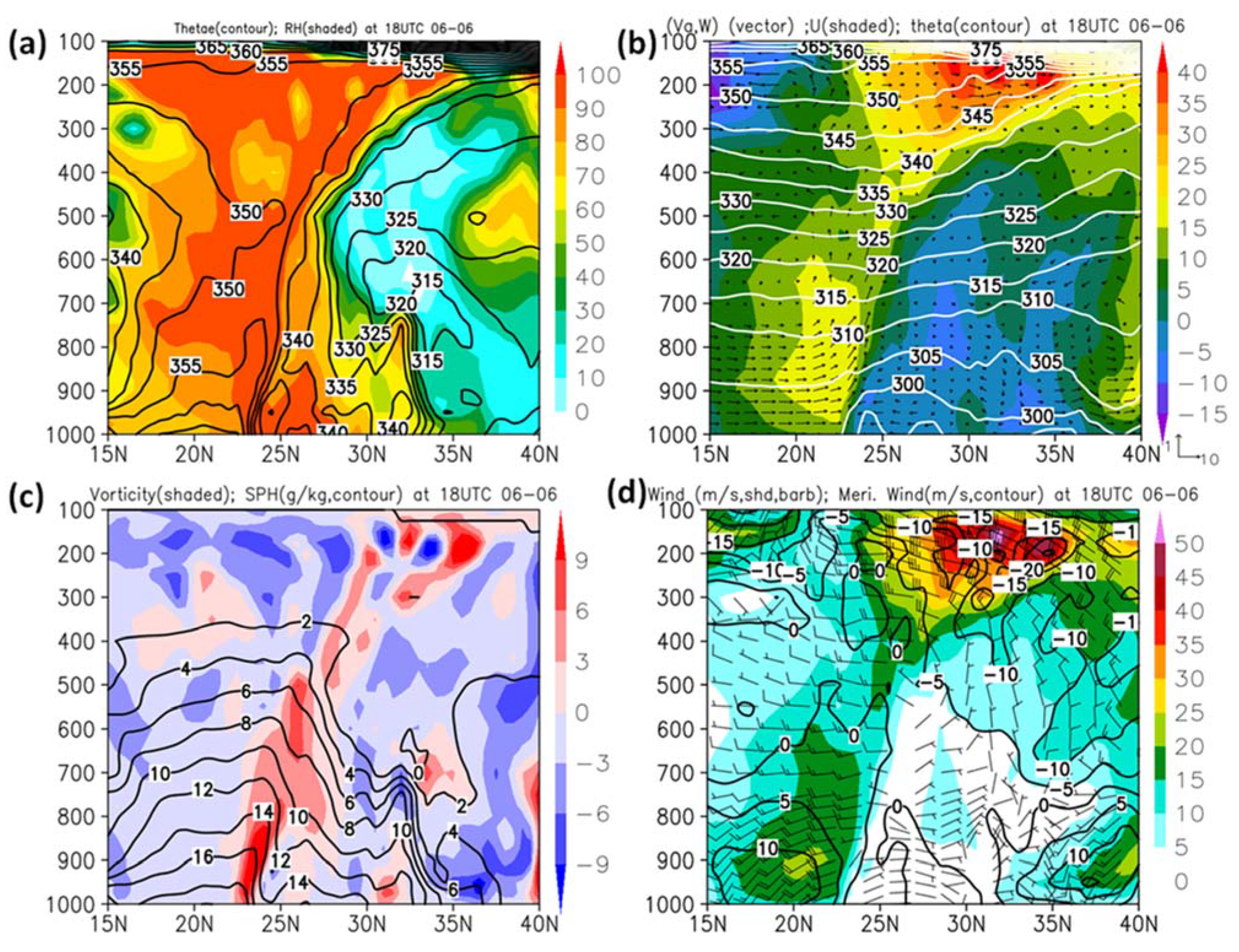

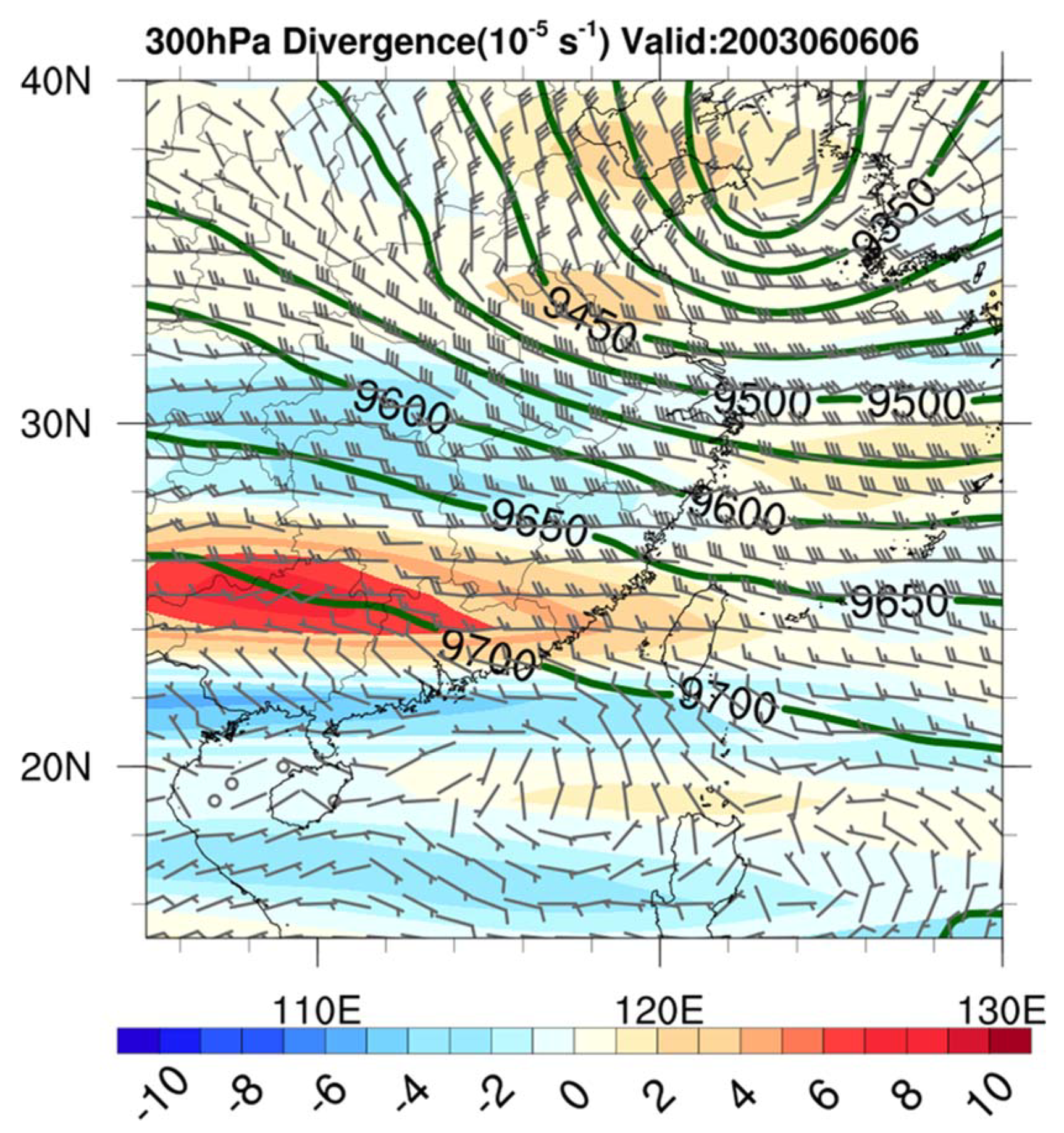
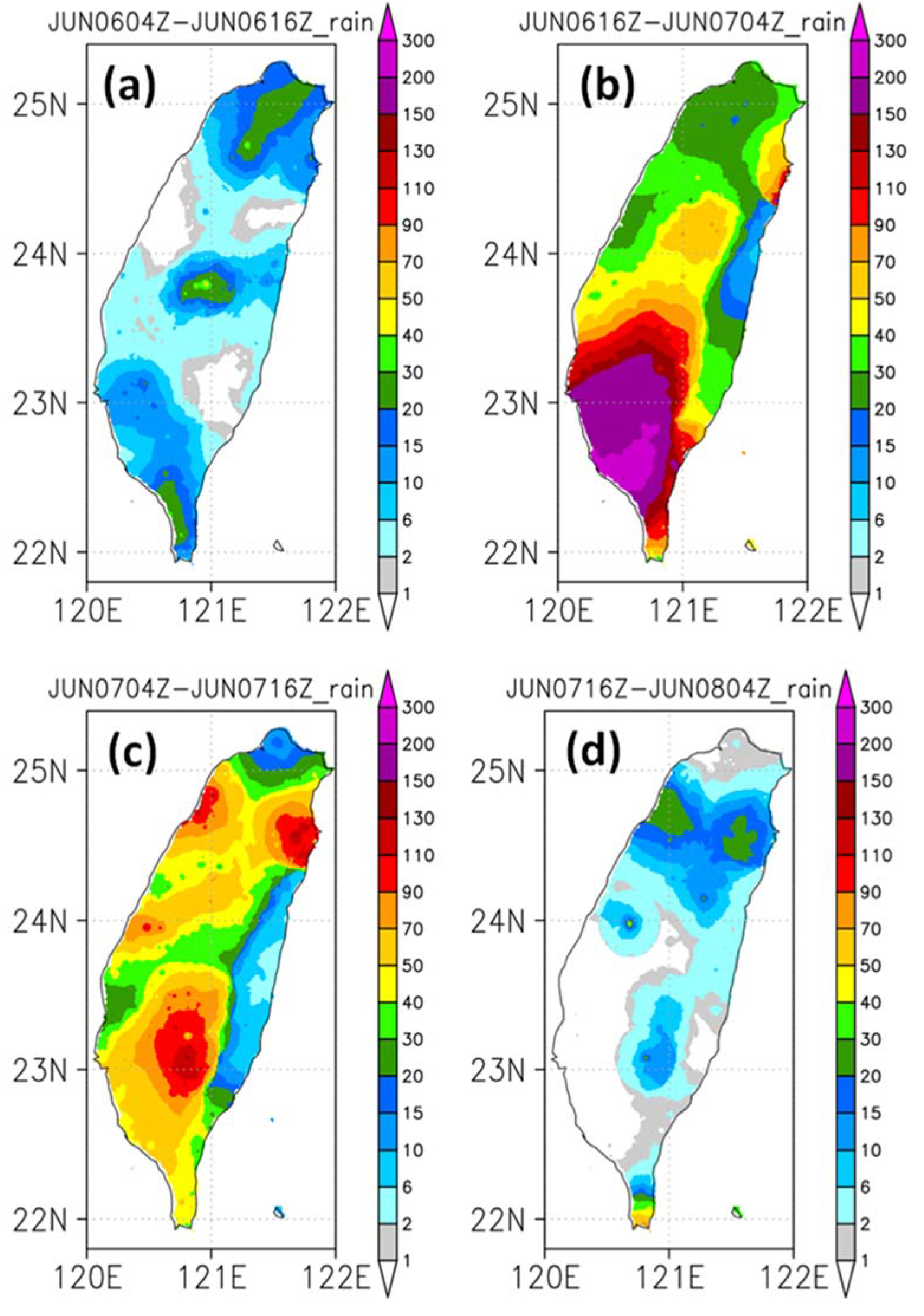
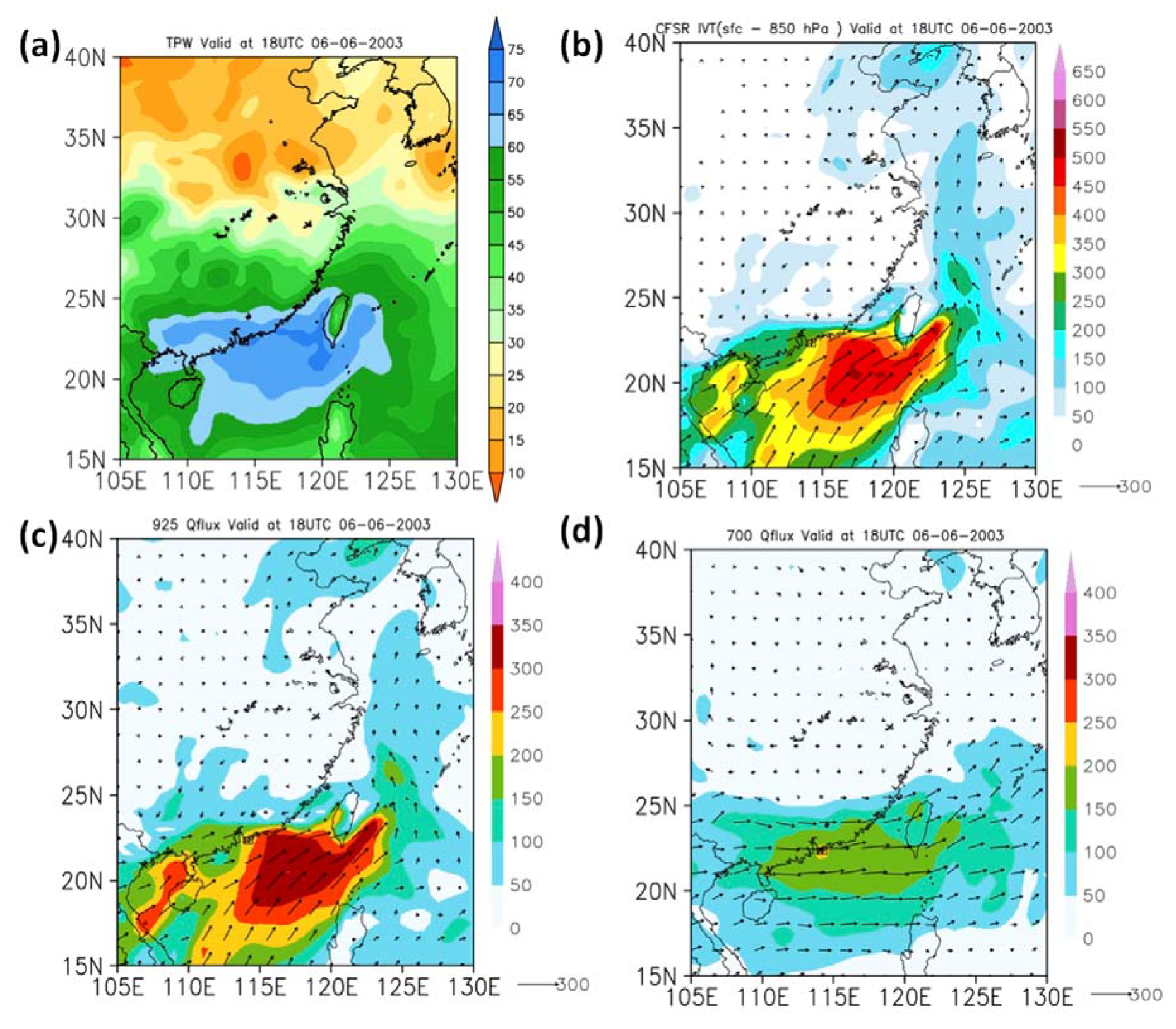
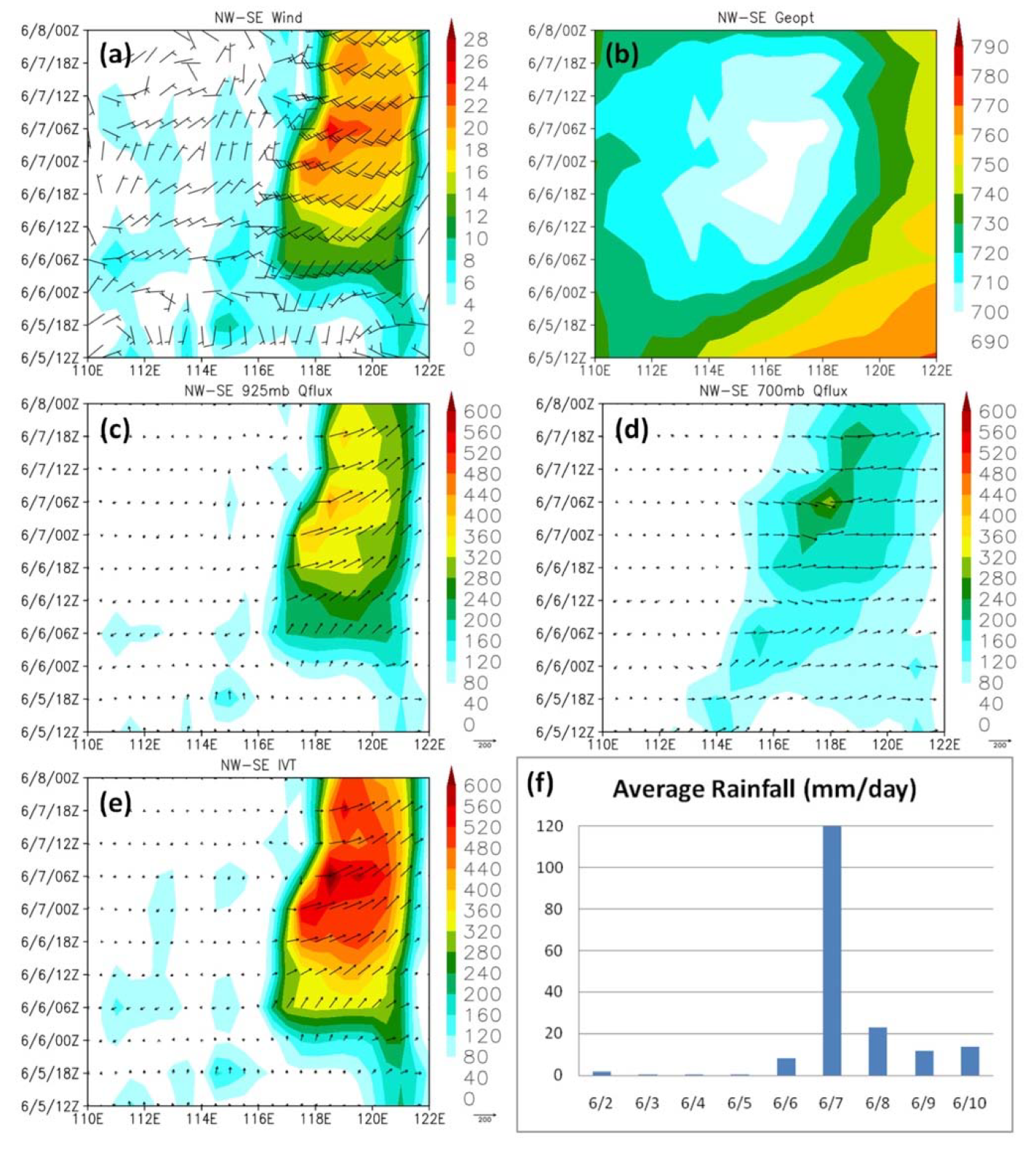
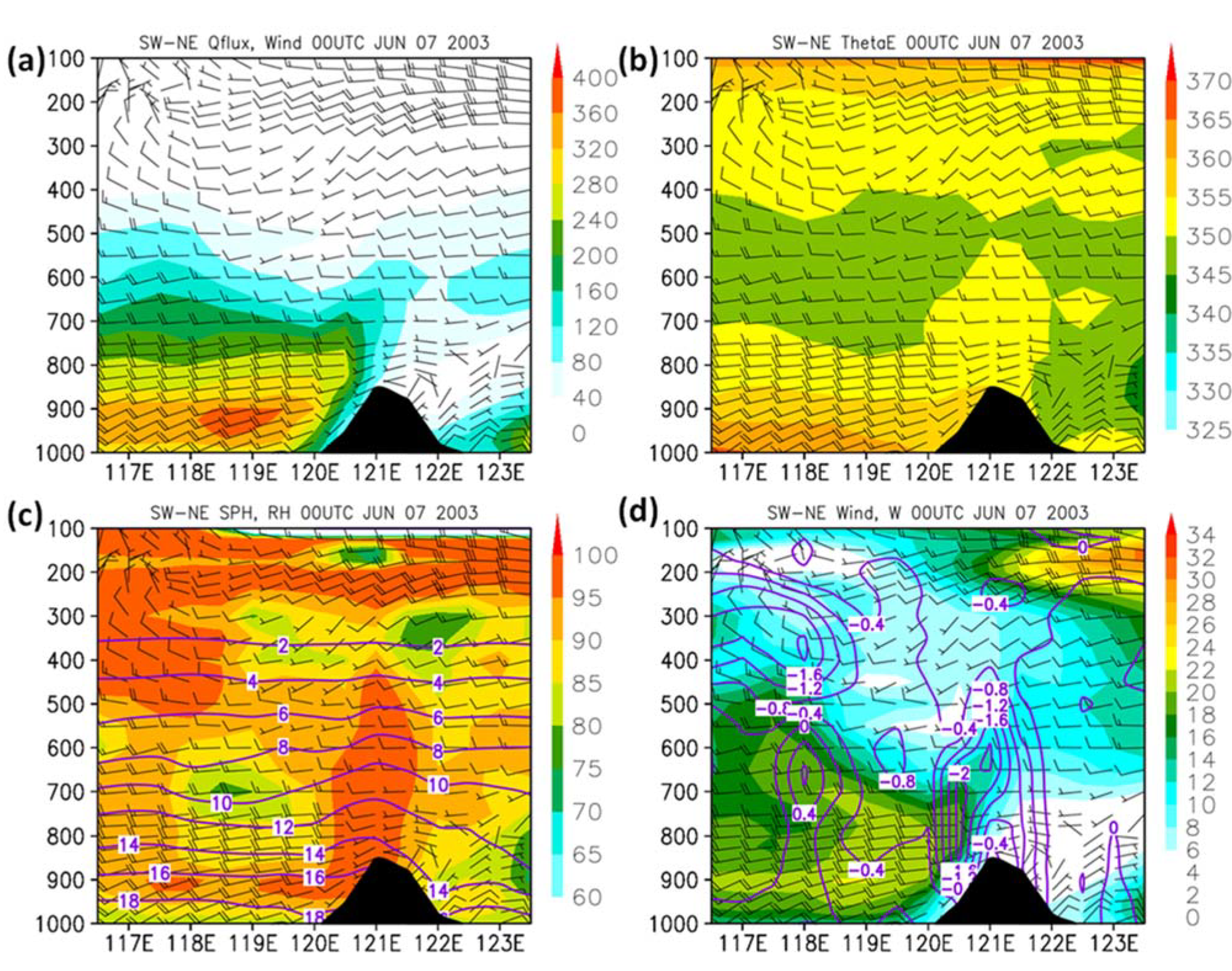

Publisher’s Note: MDPI stays neutral with regard to jurisdictional claims in published maps and institutional affiliations. |
© 2022 by the authors. Licensee MDPI, Basel, Switzerland. This article is an open access article distributed under the terms and conditions of the Creative Commons Attribution (CC BY) license (https://creativecommons.org/licenses/by/4.0/).
Share and Cite
Chen, Y.-L.; Wang, C.-K.; Tu, C.-C.; Hsiao, F.; Lin, P.-L. Revisiting a Mei-Yu Front Associated with Heavy Rainfall over Taiwan during 6–7 June 2003. Atmosphere 2022, 13, 644. https://doi.org/10.3390/atmos13050644
Chen Y-L, Wang C-K, Tu C-C, Hsiao F, Lin P-L. Revisiting a Mei-Yu Front Associated with Heavy Rainfall over Taiwan during 6–7 June 2003. Atmosphere. 2022; 13(5):644. https://doi.org/10.3390/atmos13050644
Chicago/Turabian StyleChen, Yi-Leng, Chuan-Kai Wang, Chuan-Chi Tu, Feng Hsiao, and Pay-Liam Lin. 2022. "Revisiting a Mei-Yu Front Associated with Heavy Rainfall over Taiwan during 6–7 June 2003" Atmosphere 13, no. 5: 644. https://doi.org/10.3390/atmos13050644
APA StyleChen, Y.-L., Wang, C.-K., Tu, C.-C., Hsiao, F., & Lin, P.-L. (2022). Revisiting a Mei-Yu Front Associated with Heavy Rainfall over Taiwan during 6–7 June 2003. Atmosphere, 13(5), 644. https://doi.org/10.3390/atmos13050644






